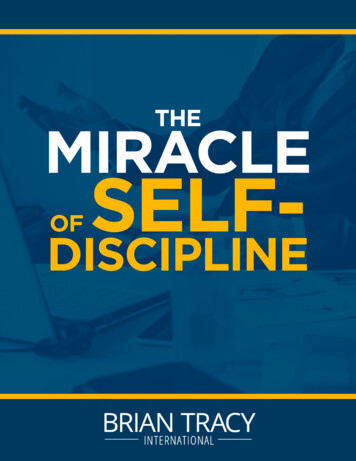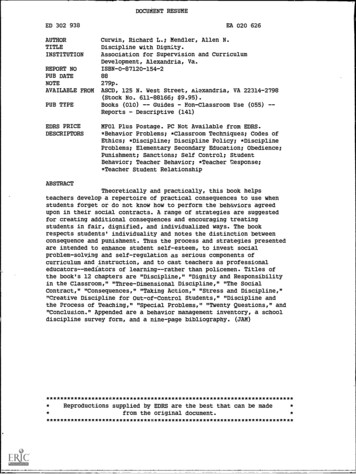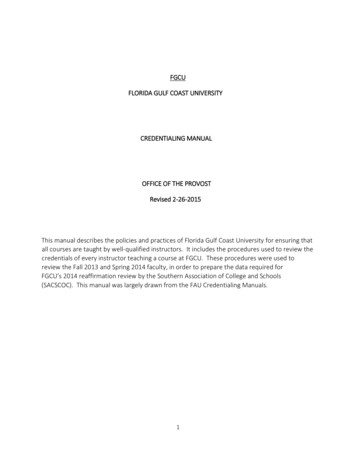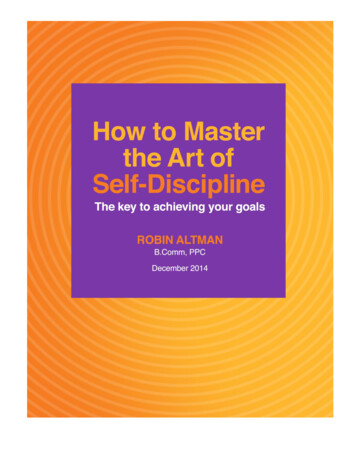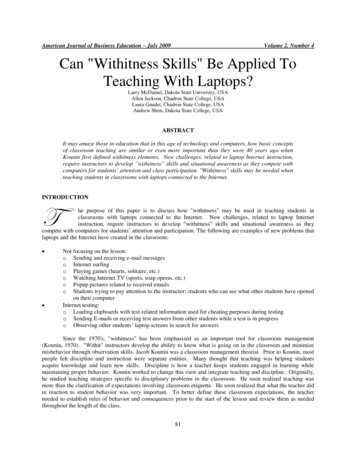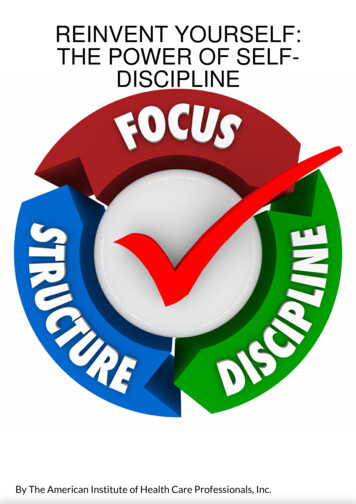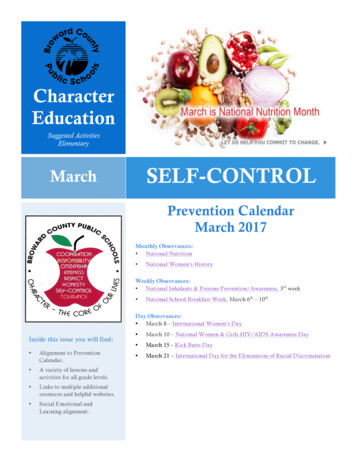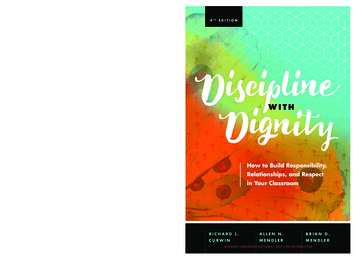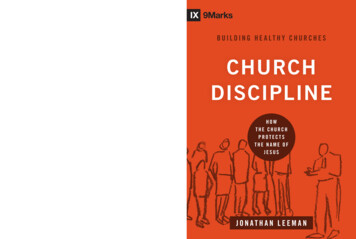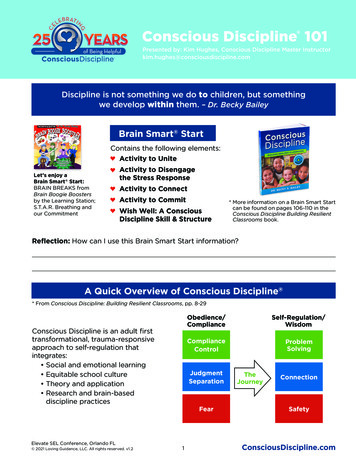
Transcription
Conscious Discipline 101 Presented by: Kim Hughes, Conscious Discipline Master line is not something we do to children, but somethingwe develop within them. – Dr. Becky BaileyBrain Smart StartContains the following elements:Activity to UniteLet’s enjoy aBrain Smart Start:BRAIN BREAKS fromBrain Boogie Boostersby the Learning Station;S.T.A.R. Breathing andour CommitmentA ctivity to Disengagethe Stress ResponseA ctivity to ConnectActivity to CommitW ish Well: A ConsciousDiscipline Skill & Structure*M ore information on a Brain Smart Startcan be found on pages 106-110 in theConscious Discipline Building ResilientClassrooms book.Reflection: How can I use this Brain Smart Start information?A Quick Overview of Conscious Discipline * From Conscious Discipline: Building Resilient Classrooms, pp. 8-29Conscious Discipline is an adult firsttransformational, trauma-responsiveapproach to self-regulation thatintegrates: Social and emotional learning Equitable school culture Theory and application Research and brain-baseddiscipline FearElevate SEL Conference, Orlando FL 2021 Loving Guidance, LLC. All rights reserved. .com
Conscious Discipline has two puzzle pieces:1. S hifting your mindset about conflict; learning about and internalizing the Powers andSkills of Conscious Discipline so you can see CONFLICT as an opportunity to teachmissing skills.Structures for Creating a School Family Our FOCUS CHANGESas Age Brain Smart Start,Safe Place, SafekeeperAttentionAssertivenessVisual Routines,Class-Made BooksUnityEncouragementConnecting Rituals,Kindness Tree, JobsFree WillChoicesVisual RulesAcceptanceEmpathyWe Care CenterLovePositive IntentWish Well, Celebration,School FamilyAssembliesIntentionConsequencesClass Meetings,Time MachineRegulates YouRegulates ChildPractice SkillsPOWERSKILLSTRUCTURE2. Creating a school climate, the Conscious Discipline School Family, that empowersApproacheveryone to succeed.Diagram ofConscious DisciplineCurriculumPay ItForwardHow Do You Grow Your School edTime7Reflect:Elevate SEL Conference, Orlando FL 2021 Loving Guidance, LLC. All rights reserved. v1.22ConsciousDiscipline.com
Conscious Discipline Brain State Model* From Conscious Discipline: Building Resilient Classrooms, pp. 34-59The Conscious Discipline Brain State Model helps us recognize that internal statesregulate external states, and is used to demonstrate the relationship between brainfunction and behavior.EXECUTIVE State:Executive StateDevelopmental Need:Problem-solving opportunitiesLooks like: Wisdom, unlimited skillsMessage: What can I learn?EMOTIONAL State:Emotional StateDevelopmental Need: ConnectionLooks like: Back talk, sass, yelling,verbal reactionsMessage: Am I loved/connected?Survival StateSURVIVAL State:Developmental Need: SafetyLooks like: Hiding, fighting, surrender,physical reactionsMessage: Am I safe?Want to understand more about this model? Check out Dr. Becky Bailey at TEDx - Wiring the Brain forSuccess at https://www.youtube.com/watch?v cjVJV7G8x3sTraditional Discipline vs. Conscious Discipline:What’s the Difference?Traditional DisciplineConscious DisciplineExternal ModelStimulus: ReactInternal ModelStimulus – PAUSE – ResponseYou can make others change.Changing ourselves createschange in others through dynamicinteractions.Rules govern behavior; rewardsand punishment are the foundationfor changing behavior.Relationships govern behavior;connection is the foundation forchange and encourages willingness.Avoid conflict; it is disruptive.Conflict is a reflection of missingsocial or emotional skills and createsopportunity to teach life skills.WHY and HOW our internal states dictate our external behavior: “When we are not conscious of our actions, we can become reactive rather thanproactive the stimulus equals an automatic reaction. Putting the PAUSE betweenthe stimulus and the response is at the core of Conscious Discipline.”– From Conscious Discipline: Building Resilient Classrooms, p. 10 “Emotional states are contagious; mirror neurons ensure that the moment someonesees an emotion on your face, they will at once sense that same feeling withinthemselves.” – Daniel SternElevate SEL Conference, Orlando FL 2021 Loving Guidance, LLC. All rights reserved. v1.23ConsciousDiscipline.com
Conscious Discipline is an adult first model; the adult’s internal state dictates theirbehavior, and their internal state dictates the child’s internal state. Adults must regulatethemselves before they can teach effectively. When we get stressed, Active Calming is our journey from our Survival State toExecutive State so we can respond instead of react. When we shift from reacting from the lower centers of our brains to responding fromthe higher centers of our brains, it is called Self-Control. When we teach others how toshift from reacting from the lower centers of their brains to responding from the highercenters of their brains, it is called Conscious Discipline.Upset is YOUR cue toPAUSE S.T.A.R. BREATHE/SELF-TALK WISH WELLUsing conflict as an opportunity to teach social, emotional and life skills: Learn to Q-TIP! Quit Taking It Personally. Mistaken behavior it’s NOT happening TO you; it’s happening IN FRONT of you. All behavior is communication. Adults (AKA behavior detectives) must figure outwhat the behavior is saying. There is a difference between misbehavior and mistaken behaviors. Conscious Discipline sees behavior as a “call for help” instead of “he’s ruining my day.”Reflect upon and then record key differences between Traditional Discipline andConscious Discipline.Elevate SEL Conference, Orlando FL 2021 Loving Guidance, LLC. All rights reserved. v1.24ConsciousDiscipline.com
Activity: Now, you will share your ideas with other participants. When the music stops,you will find a partner and share one key difference. Music will cue when to stop and go.Continue playing until Kim tells you to stop.Something to ponder:You see a student flipping her desk ina classroom. You think.Let’s watch whatcan happen when aneducator embracesConscious Discipline(Jill Beck’s Story).a) She knows better than that.b) That wouldn’t happen in my classroom.c) Oh no she didn’t! She needs a good.d) None of the above.Reflect: Take one minute to jot down some thoughts you have after watching this video.Consider Using This Iceberg AnalogyOne major takeaway.One thing I am going to do.Elevate SEL Conference, Orlando FL 2021 Loving Guidance, LLC. All rights reserved. v1.25ConsciousDiscipline.com
Recap of Conscious Disciplinel Is an Adult First, Child Second systemic SEL program, empowering adults with themindset and skill set to infuse SEL in all daily teaching moments.l Is a Student-Centered approach.n Conscious Discipline empowers all students to contribute to and co-create asafe and supportive learning environment, in collaboration with the adults intheir school.n Considers and addresses students’ needs through a Whole Child perspective.n Recognizes that students’ sense of safety and quality of connection directlyrelates to their ability to learn. Adults develop the mindsets and strategiesneeded to support these areas of their students’ lives, considering not onlyexperiences at school, but in their families and communities as well.l Promotes Equity.n The Conscious Discipline approach is an “Adult-First” model, infused withopportunities for self-reflection. Often, adults recognize and confront theirdeeply held beliefs and biases. This, coupled with practice to see studentbehaviors with positive intent and to identify the underlying messages beingcommunicated, reduces the tendency to react using punitive or exclusionarydiscipline, particularly where biases might have otherwise influenced decisions.n The Conscious Discipline School Family helps schools create an environmentmodeled after a “healthy family model,” in which all members are seen asindispensable to the community and are never excluded. Challenges and conflictare viewed as opportunities for all members to develop skills and deepen theirtrust and empathy for one another. All teachers, staff, and students benefitfrom this inclusive and healing-centered approach.l Is a model for Continuous Learning.n Rather than one-off trainings, Conscious Discipline is a transformational model.Schools develop supportive professional communities that engage in ongoingreflection and learning that continuously impact practice, where mistakes areseen as opportunities to learn. Likewise, adults who experience this modelencourage their students to learn from every interaction and experience throughongoing self-reflection and commitment.l Is brain-based and trauma-informed/reflective, providing understanding and skillsto intervene, knowing the “why” and the “how”.Elevate SEL Conference, Orlando FL 2021 Loving Guidance, LLC. All rights reserved. v1.26ConsciousDiscipline.com
Attention Assertiveness Visual Routines, Class-Made Books Unity Encouragement Connecting Rituals, Kindness Tree, Jobs Free Will Choices Visual Rules Acceptance Empathy We Care Center Love Positive Intent Wish Well, Celebration, School Family Assemblies Intention Consequences Class Meetings, T
